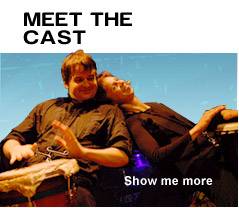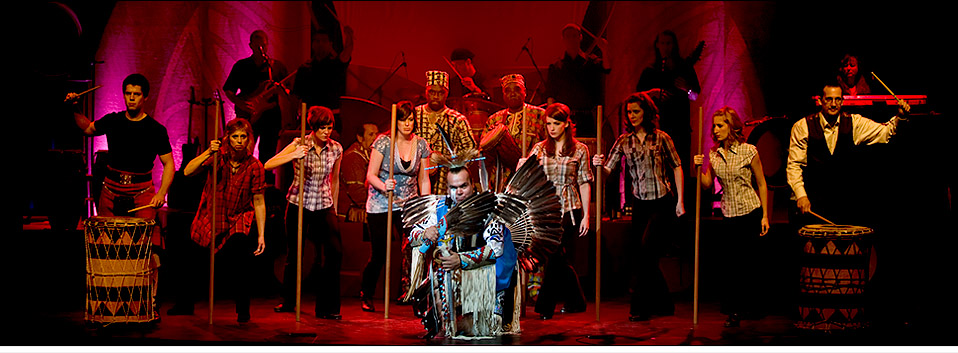|
February 11, 2008
DRUM! at Massey Hall
The British may have had the empire, but they don't make it into DRUM! The exuberant Nova Scotia song and dance show features four of the founding cultures of the province - Mi'kmaq, Acadian, Celtic and African. The British do rate a brief appearance, but only as two soldiers drumming the Acadians into expulsion. If the rulers of the world had had a catchy song-and-dance style associated with them, they too might have joined the conquered on stage.
DRUM! is an international success. The show began as a 45-minute tourism spectacle created by producer Brookes Diamond to be performed at international conferences and special events like Halifax's Tall Ships 2000.
Developed into a full-length production in 2004, the foot-tapping extravaganza has been touring Canada and the United States to rapturous reviews ever since. Its first visit to Toronto brought out a large and enthusiastic crowd. I bought the CD the minute the show was over.
The heart of DRUM! is, not surprisingly, a panoply of drums that embraces all the cultures, from native hand drums, to the Celtic bodhran and the African djembe. The cast also plays a plethora of percussion instruments including the Cajun washboard, Acadian spoons and African shakers.
The first thing that strikes one about DRUM! is its integration. The logical staging would have been each of the cultures doing its own thing.
However, the original and current director/choreographer, Timothy French and Daryl Cloran respectively, have mixed the 20 multiracial cast members completely together for almost every number.
For example, a rousing gospel tune performed by singers Novelee Buchan and Dutch Robinson is backed up by the whole company including Hubert Francis and Stewart Augustine banging out the beat on a native ceremonial drum.
When the native performers sing and drum a song, the rest of the cast joins them in back-up vocals and instrumentals. I'm sure it's a first for the conga and the bongo to appear in a Mi'kmaq song.
There is a core trio of musicians on drum kit, bass and guitar who also do back-up vocals. A winsome female quartet performs the Irish and Acadian step dances and Scottish Highland flings, but also plays percussion instruments as needed.
In fact, this is one of the most multitasking groups I have ever seen on stage. For example, Doris Mason, Lisa MacDougall and Anna Ludlow all show a wonderful a capella harmony in a plaintive Celtic folksong, but are adroit musicians on keyboards, accordion and fiddle respectively. Mason is also the touring show's music director.
Snare drums (I presume associated with the Celtic culture) make an appearance in the enormously deft hands of the precision drummers of a squad called Squid. These four young men, with glowing, multicoloured drum sticks, stand in a line and execute a routine of rapid fire drum beat patterns that brought down the house. Squid's Ryan Fraser is also the show's bagpiper.
The set design has various levels for the barrage of instruments and a central projection screen on the back wall with narrative titles and suitably ethnic pictures for each sequence. Dana Osborne's colourful costumes, needless to say, cover the waterfront.
The first half introduces the four cultures in a joyous outpouring of song and dance. Francis and Augustine are the stately and elegant storytellers, Buchan and Robinson belt out fabulous gospel and R&B, while Acadian Len Le Blanc dazzles by hitting himself all over his body with the spoons at lightning speed. The dancers whip through the rhythmic step dances and graceful on-the-toes Highland flings with aplomb.
The darker second half, built around a recording of Mi'kmaq poet Rita Joe and her heartfelt words from I lost My Talk, evokes a collage of hardships. The conquering of the natives, the expulsion of the Acadians, the clearing of the Highlands, the slavery of the blacks, and even references to both World Wars, is masterfully done in choreographed rhythmic patterns using dance and drums. That their cultural traditions, especially for the natives, Acadians and Celts, were almost lost is the subtext of these vignettes.
The ending is, of course, finding the talk. There is a poignant rendering of the Lord's Prayer sung by Robinson and spoken by Francis which segues into a rapturous celebration that involves a complex series of drumming and dancing, not to mention singing.
If I have one cavil, it is that each half is too short, the show running about 80 minutes in total. If there were a way to perform DRUM! without an intermission, or add new numbers to fill out time, that would be perfection.
PAULA CITRON
|
|
|
![]()
![]()
 |
 |
 |
 |

![]()
  |  |   |
![]()
